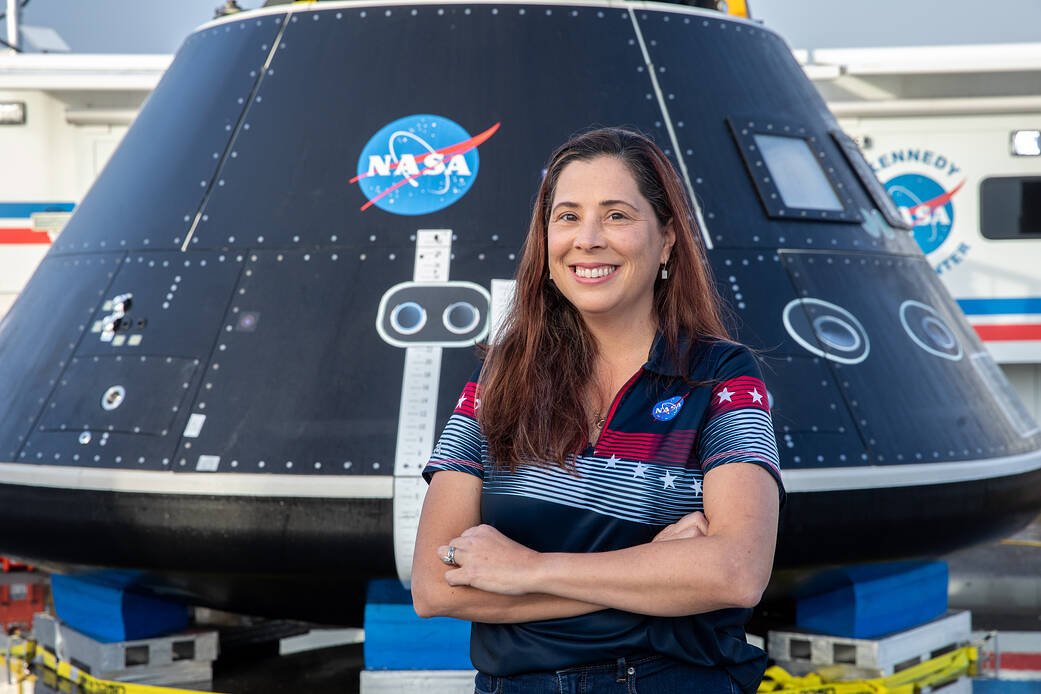“From an early age, I wanted to be an astronaut. I remember going to Kennedy Space Center Visitor Center when I was 7 on a family trip, and we got to see the rockets in the Rocket Garden and learn all about the Moon landings. I had no idea that humanity had ever been in space, much less landed on the Moon. When my family moved from Colombia to the United States when I was 10 years old, I remember thinking, ‘Maybe I have an opportunity to work in the space industry when I get older now that I live here.’
“Back then, we didn’t have Google, so I went to the library because I wanted to find out, ‘How do you become an astronaut?’ And I remember looking through the encyclopedias that they had and looking at the current astronauts that were on the books and their bios — in particular, the females, because if they could do it, maybe I could. A lot of the astronauts had aerospace engineering as their degree, but a lot of them were also military pilots. So, I figured, OK, I’m going to try to do both routes and see if I could get in, and from that day on, I wanted to be an aerospace engineer. Unfortunately, my path as a military pilot ended the moment that I failed my driver’s permit vision test at 15 years old. Back then, the military would only accept people with perfect 20/20 vision.
“I kept applying for jobs [at] Boeing because I knew they were working on the International Space Station, and I’m like, ‘I need to work for NASA, this is my path in.’ And I just pestered those guys down in Florida, and one of them eventually called me after I moved back and said, ‘Hey, we have a job. Would you like to interview?’ And I’m like, ‘Of course!’ And I remember my first day coming into Kennedy Space Center and seeing the Vehicle Assembly Building. … It was very emotional because I couldn’t believe that I was here.
“It’s amazing when I get a chance to see the space station fly over. I am very fortunate to be able to say that my hands were on a lot of the hardware that is up there. I’m very proud to have been part of the International Space Station program.”
— Liliana Villarreal, Artemis Landing and Recovery Director, Exploration Ground Systems, NASA’s Kennedy Space Center
Image Credit: NASA / Kim Shifflet
Interviewer: NASA / Michelle Zajac
Check out some of our other Faces of NASA.
“从很小的时候起,我就想成为一名宇航员。我记得我7岁的时候全家去了肯尼迪航天中心游客中心,我们在火箭花园里看到了火箭,了解了登月的所有信息。我不知道人类曾经去过太空,更不用说登月了。当我10岁的时候,我的家人从哥伦比亚搬到美国,我记得当时我在想,‘既然我现在住在这里,也许我长大后有机会在航天工业工作。’
“那时候,我们还没有谷歌,所以我去了图书馆,因为我想知道,‘你怎么才能成为一名宇航员?’我记得我翻阅了他们的百科全书,看了看书里的现任宇航员和他们的简历——尤其是那些女性宇航员,因为如果她们能做到,也许我也能。很多宇航员都有航空航天工程的学位,但他们中的很多人也是军事飞行员。所以,我想,好吧,我要尝试两条路线,看看我能不能进去,从那天起,我想成为一名航空航天工程师。不幸的是,在我15岁没有通过飞机驾驶执照视力测试的那一刻,我的军事飞行员之路就结束了。那时候,军队只接受视力完全正常的人。
“我一直在申请波音公司的工作,因为我知道他们在国际空间站工作,我想,‘我需要为NASA工作,这是我的出路。’我就不停地缠着佛罗里达的那些人,在我搬回来后,其中一个最终打电话给我说,‘嘿,我们找到了一份工作。你想面试吗?’我说,‘当然!我还记得我第一天来到肯尼迪航天中心,看到飞行器组装大楼。我非常激动,因为我不敢相信我在这里。
“当我有机会看到空间站飞过时,真是太棒了。我很幸运能够说,我的手是在那里的很多硬件。我很自豪能成为国际空间站项目的一员。”
–莉莉安娜·比利亚雷亚尔,NASA肯尼迪航天中心探测地面系统阿尔忒弥斯着陆和回收主任
图片来源: NASA / Kim Shifflet
采访者: NASA / Michelle Zajac







